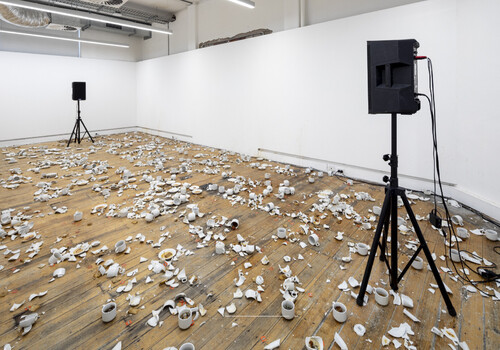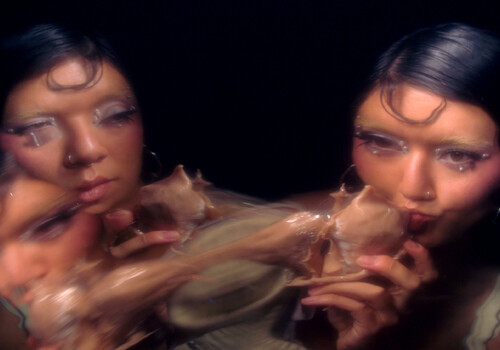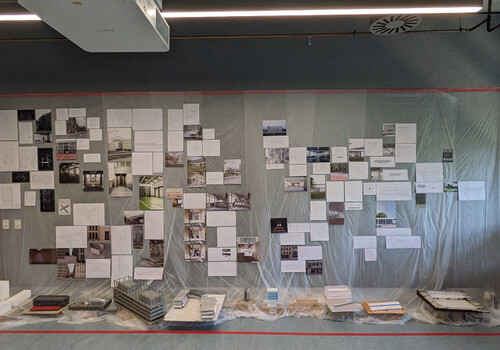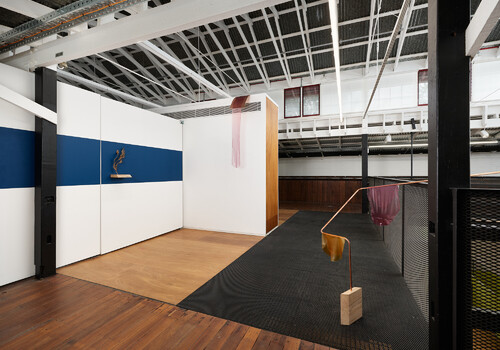Bachelor of Fine Art, UNSW Art & Design
By Elle Monera
I’m weaving my way through The Annual, and I’m fraying around the edges. My body is capering through the courtyard where the DJ is set up, a little cup of Sauv Blanc in my hand. But it’s not the flurry of opening night that has left me feeling unsteady. Throughout the grad show, I am yanked into sundry imagined worlds and alternate futures, hemmed by the deft hands of my fellow graduands. I am familiar with the pull to speculate; amid a slew of compounding crises, we must contend with ceaseless uncertainty. As an artistic strategy, liminal worlds offer us the chance to unstitch the destructions and inequalities of the present and to reconstitute our realities anew.

Installation view of Ada Eni Xu, Mythica-Huàn, 2024, etching, aquatint on xuan paper, UNSW Art & Design, Sydney. Photo: Jessica Maurer.
Tucked into the corner of an exhibition room at UNSW Galleries, Ada Eni Xu’s Mythica-Huàn (2024) possesses a magnetic power, beckoning me in despite its inconspicuous placement. Surrendering to its pull, I become enfolded by translucent vertical scrolls suspended from the ceiling by red threads. Each scroll features Xu’s skilful etchings of ancient Chinese mythologies. In their artist statement, Xu says that Mythica-Huàn is both a love letter to their cultural heritage and an exercise of speculative futuring, done through reassembled mythological iconography. The collateral outcome is a temporal topsy-turvy, in which the membrane between the artwork and viewer has burst. For a moment, I lose my friends among the ghostly scrolls—I sense only their shadows, faintly warping and disappearing behind the paper. My body feels suspended in a delicate threshold between past, present, and future.

Detail view of Ada Eni Xu, Mythica-Huàn, 2024, etching, aquatint on xuan paper, UNSW Art & Design, Sydney, https://annual.artdesign.unsw.edu.au/profile/ada-eni-xu. Photo: Ada Eni Xu.
Aya Nomoto’s Fragile Armour (2024) also operates within a space of liminality. Examining the splintered nature of diasporic selfhood, Nomoto fashions a patchwork garment, which takes after the Japanese boro technique of mending and reworking textiles. Fragile Armour constellates disparate materials, memories, and temporalities, constituting what Nomoto calls an “abstracted self-portrait.”
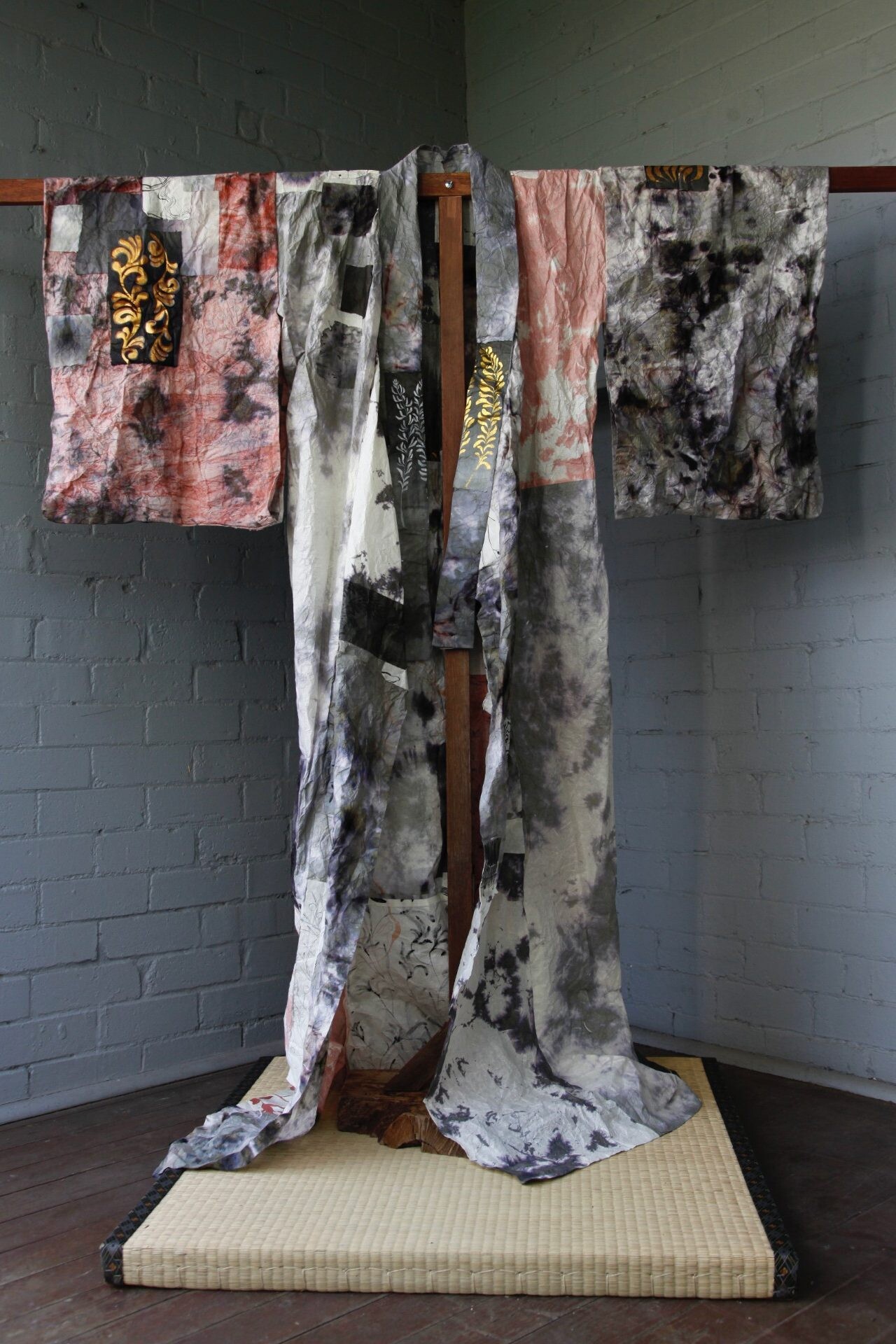
Installation view of Aya Nomoto, Fragile Armour, 2024, calligraphy ink and watercolour on Japanese rice paper, 163cm x 179.5 cm x 20cm, UNSW Art & Design, Sydney, https://www.unsw.edu.au/arts-design-architecture/our-schools/art-design/student-work/tim-olsen-drawing-prize/tim-olsen-drawing-prize-2024/aya-nomoto. Photo: Aya Nomoto.
Based on the length and sheerness of the fabric, my friend speculates that Nomoto’s garment is not the main kimono itself but an underlayer. “A nagajuban, maybe?” she muses. Undergarments like the nagajuban (長襦袢) are typically worn between the skin and the outer layers to protect the outermost kimono from being damaged by the wearer’s sweat. These are typically white-coloured and can sometimes be seen peeking from beneath the collar of the main kimono. My friend astutely observes that Fragile Armour was probably originally white. “If this really is the undergarment,” she ponders, “what does it mean that it’s now discoloured, painted over, and made the centre of our attention?” A salient question.

Detail view of Aya Nomoto, Fragile Armour, 2024, calligraphy ink and watercolour on Japanese rice paper, 163cm x 179.5 cm x 20cm, UNSW Art & Design, Sydney, https://www.unsw.edu.au/arts-design-architecture/our-schools/art-design/student-work/tim-olsen-drawing-prize/tim-olsen-drawing-prize-2024/aya-nomoto. Photo: Aya Nomoto.
But I’m busy feeling haunted. Positioned upright on a wooden stand with its arms regally outstretched, Fragile Armour appears eerily disembodied. The stiffened fabric of the garment makes it look as if it’s been draped over an absent body, as if there is a ghost in our midst, just slightly out of our reach.
From the end of a narrow corridor, I hear a sweet, lilting voice calling to me, “Now, you might be thinking—where does your virginity go when you lose it?”

Installation view of Brynn Elysia, UnHoly Cherry: Please Come Again, 2024, multi-channel video installation with sound [00:04:30], fabric, clay and gelatin, UNSW Art & Design, Sydney. Photo: Jessica Maurer.
I follow the voice to its source: a cosy room at the end of the hall, softly emitting pink and purplish lights. It’s Brynn Elysia’s three-channel video installation, Unholy Cherry: Please Come Again (2024). Approaching the work, I am flanked by coquettish paraphernalia: silk drapes, pink chiffon, disembodied yonic sculptures, and pearl jewellery. There are three screens transmitting ethereal figures clad in white lace and satin—they are introduced to me as salesclerks from “Purgatory Incorporated,” an imagined realm in which “virginity actually exists!” In front of me is a thick, fleshy pen and a document entitled “Eternally Pure Subscription Contract.” The clerks, smiling coyly, are goading me to sign it.
Elysia’s fabricated reality playfully contends with the suppression and regulation of sexual agency in our dominantly hetero-patriarchal, capitalist system. Toward the end of the video, the clerks begin circling me like vultures. The once-lovely voice of the narrator, which had seduced me into the installation not so long ago, has warped into a grating, staticky distortion. “You will be pure forever,” they taunt, echoing endlessly like a ritualistic chant. The clerks’ faces are melting—smearing across the screen, trapping me in a whorl of glittery faces. Is it just the Sauv Blanc, or am I seeing double?

Film still from Brynn Elysia, UnHoly Cherry: Please Come Again, 2024, multi-channel video installation with sound [00:04:30], fabric, clay and gelatin, UNSW Art & Design, Sydney, https://annual.artdesign.unsw.edu.au/profile/brynn-elysia. Courtesy of Brynn Elysia.
An indefinite amount of time passes before a gallery worker stirs me; they inform me that the show’s about to close. Reluctantly parting with Unholy Cherry, I emerge into the balmy evening, feeling like a rogue spindle. I am frayed at the edges. How does one stitch oneself back together after being thoroughly unwound? Alternatively, what happens if one permits oneself to unravel?
Elle Monera (they/she) is an emerging writer based on unceded Gadigal land. They are currently completing a Bachelor of Fine Arts (Art Theory) at UNSW Art & Design.





